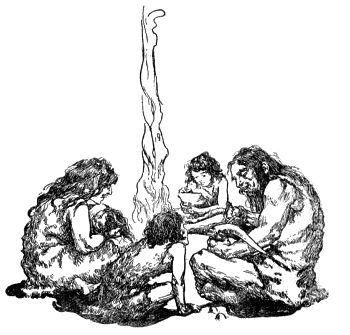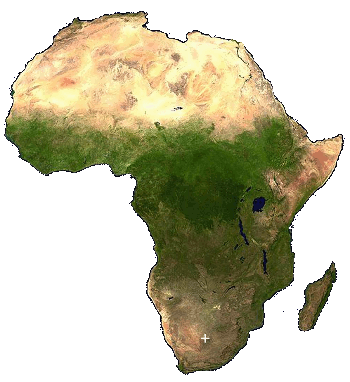Fire
April 20, 2012
Perhaps the most useful
technological advance in the history of
humankind is the control and use of
fire. I used "fire" often in my
laboratory work, although my fires were typically at 1200
°C, quite a bit above the temperature of a static
wood fire (~600 °C). It's easy to list some important uses of fire among
primitive man.
• Hunting (Using a ground fire to chase big game towards a band of spear throwers; or, over a cliff).
• Smoking bees from their hive.
• Campfires and torches to repel predators.
• Cooking.
• Using smoke to preserve animal hide and meat.
• Heating.
• Lighting.
• Softening tar and pitch to use as an adhesive.
• Wood working (burning cavities into wood for vessels; making spear tips.
• Firing pottery.
• Signal fires.

It's thought that fire is responsible for the contours of the modern
human face, since the tenderizing action of cooking eliminated the need for heavy
jawbones, large
teeth, and massive facial
muscles.
Fire is possibly the reason that man became civilized, since humans were induced to sit around communal campfires.
(
Illustration from "The Cave Boy of the Age of Stone," by Margaret A. McIntyre.[1]
In today's world, every major technological advance invariably leads to other advances, usually quite quickly. That's what makes the long span between the first use of fire and subsequent advances in the human condition so curious. As I summarized in a
previous article (Stone-Age Internet, October 27, 2011), technological advancement in these primitive cultures was limited by the
diffusion of information.
A simple
percolation model shows that a critical
population density is required to allow information diffusion throughout a population.[2-3] The use of
stone as the sole human tool persisted from about 2.5 million years ago (the
Lower Paleolithic) until about 5,000 years ago, possibly because the human population was too small for effective information diffusion before that time. The
metallurgy of
copper and
bronze was developed after the
Stone Age, marking the start of the
Bronze Age.
There's no question that
written language had a major impact on information diffusion. One of the earliest written artifacts is the wonderfully preserved
Phaistos Disc, a fired
clay disc, about half a
foot in
diameter, with stamped
symbols. This disc is dated to the
Minoan Bronze Age, about four thousand years ago.

Both sides of the Phaistos Disc, via Wikimedia Commons)
The Phaistos script has not been
deciphered, since it is unlike other languages. It might not be a script at all, but just an array of
pictographs that aided in the telling of a story. In any case, verified examples of true script, such as
Linear A, appear at about the same time.
Not too far behind the
invention of writing is the technological advance of
iron smelting, which marked the start of the
Iron Age at about 1,200
BC. This is quite a time after the conventional dating of the human use of fire at the transition from the
Lower Paleolithic to the
Middle Paleolithic, about 300,000 years ago. In fact, the use of fire is considered to be the distinguishing characteristic of this transition.
Possible evidence for the earlier use of fire has been found, but the consensus among
archaeologists is that the Lower Paleolithic-Middle Paleolithic transition, 300,000 years ago, marks the start of fire use. Now, a multinational team of archaeologists has unearthed (pun intended) evidence of the human use of fire a million years ago.[4-6] This makes the huge time period between fire use and other technological advances that much larger.
Wonderwerk Cave is an archaeological rich
cave in the
Northern Cape Province of
South Africa. The cave contains a thick deposit of
sediment containing Stone Age
artifacts and remains in an exceptional state of preservation.

Location of Wonderwerk Cave (27°50'42"S 23°33'14"E)
(NASA image, via Wikimedia Commons))
The research team sampled cave sediments and found burned bone fragments and other burnt material. Importantly, these burnt materials appear to have been burned inside the cave, and they were not just washed in.[4] This is important to both the supposed process for burning, fires tended by humans, and dating of the materials. The humans in this case would have been
Homo Erectus.
Homo Erectus occupied the cave during the early
Acheulean period that occurred about a million years ago. The principal
analytical tools used by the research team were
microscopy and
Fourier Transform Infrared Spectroscopy. The authors write in their article in the
Proceedings of the National Academy of Sciences that this is the earliest evidence for human fire.[5]
References:
- Margaret A. McIntyre, "The Cave Boy Of The Age Of Stone," Harrap (London, Not Dated, Certified Public Domain by Archive.org).
- Adam Powell, Stephen Shennan and Mark G. Thomas, "Late Pleistocene Demography and the Appearance of Modern Human Behavior," Science, vol. 324, no. 5932 (June 5, 2009), pp. 1298-1301.
- M.A. Sumour, M.A. Radwan, M.M. Shabat, Ali H. El-Astal, "Statistical physics applied to stone-age civilization," arXiv Preprint Server, October 13, 2011.
- Lewis Page, "ONE MILLION YEARS B.C. - Humans begin artificial CO2 emissions," The Register (UK), April 3, 2012
- Francesco Berna, Paul Goldberg. Liora Kolska Horwitz, James Brink, Sharon Holt, Marion Bamford and Michael Chazan, "Microstratigraphic evidence of in situ fire in the Acheulean strata of Wonderwerk Cave, Northern Cape province, South Africa," Open Access Publication, April 2, 2012, Document No. 1117620109.
- Supporting Information for article in ref. 5.
Permanent Link to this article
Linked Keywords: Technology; humankind; fire; laboratory; Celsius; °C; wood; prehistory; primitive man; hunting; big game; spear; cliff; smoking; bee; hive; campfire; torch; predator; cooking; curing; preserve; animal hide; meat; wood fuel; heating; lighting; tar; pitch; adhesive; wood working; bowl; vessel; pottery; signal fire; human face; jawbone; human tooth; muscles; "The Cave Boy of the Age of Stone"; Margaret A. McIntyre; diffusion of innovation; diffusion of information; percolation theory; percolation model; population density; stone tool; Lower Paleolithic; metallurgy; copper; bronze; Stone Age; Bronze Age; written language; Phaistos Disc; clay; foot; diameter; symbol; Minoan civilization; Minoan; Phaistos Disc; Wikimedia Commons; decipherment; pictogram; pictograph; Linear A; invention of writing; iron smelting; Iron Age; BC; Lower Paleolithic; Middle Paleolithic; Possible evidence for the earlier use of fire; archaeologist; Wonderwerk Cave; cave; Northern Cape Province; South Africa; sediment; artifact; NASA; Homo Erectus; Acheulean period; analytical tool; microscopy; Fourier Transform Infrared Spectroscopy; FTIR; Proceedings of the National Academy of Sciences.